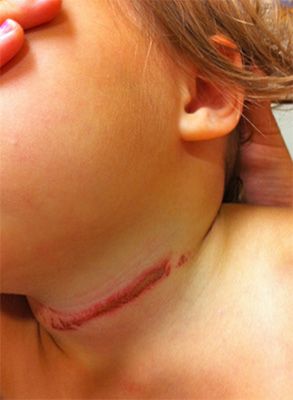Possible Choking Injury: Child Abuse-or Mimic?
A mother presented to the ED with her 3-year-old child asking about an upper respiratory infection and an incidental wound around the child’s neck.
A mother presented to the emergency department with her 3-year-old child asking about an upper respiratory infection (URI) and an incidental wound around the child’s neck. The mother reported that her 3 children had been visiting their father and the child in question had been choked by a dog leash during the visit. The mother denied any knowledge of how the accident had occurred. This injury had reportedly occurred several hours earlier, and the mother also denied being aware of any physician contact after the injury. The mother had little regard for the injury but was concerned about the URI.

Except for the neck injury and the URI symptoms, the physical examination was unremarkable. No addition tests were done at this point.
Because of the delay in seeking care and the appearance of a possible choking injury, the ED staff wanted more information about the injury before discharging the child. The father was contacted and gave an almost unbelievable account of the accident. The child was alleged to have been walking the neighbor’s dog when he became tangled in the leash. The explanation was inconceivable as first described by the father. Social service was contacted for more input into the etiology of the injury.
Has this child been abused, or is this a child abuse mimic?Answer and discussion on next page.
Answer: This was an accidental injury
The child’s siblings gave the same inconceivable history as the father. The neighbors who owned the dog also confirmed the unusual story. The father added that he had called the child’s primary care doctor at the time of injury to ask for advice. The time frame the father gave also matched the time line that was developing from the other witnesses. The primary care physician confirmed the history as given by the father. No further tests were performed.
Several features of concern
This case had several unusual features. The first was the unusual nature of the injury. The second was the apparent lack of concern the mother showed regarding how the injury occurred. The third was the apparent delay in seeking treatment.
This case provides an opportunity to discuss a not-so-common element of abuse. Suffocation is more commonly considered in cases of SIDS or near-miss SIDS. Suffocation is also seen in injuries from window blinds with long cords. Suffocation is not often considered in non-fatal abuse, however. This is for good reason; there are often few if any physical signs of suffocation.1
In the domestic abuse literature, there are some statistics that may apply as a general guide to investigating non-lethal child suffocations. In over half of attempted suffocations in adults, there are no physical signs of injury; 67% reported no symptoms related to their attempted suffocation. The most commonly reported symptom was pain (in 18%) followed by breathing problems (in 5%). Only 15% had injuries that could be seen in a photograph.2 All of this adds to physicians’ responsibility to be vigilant when we know some of these “normal” patients may succumb to their injuries in days to weeks after injury secondary to irreversible encephalopathy.3
As in most cases involving children, it is never wrong to question abuse. The only wrong is to not question.
Teaching Points:
1. A very high index of suspension is necessary to establish a diagnosis of non-lethal suffocation.
2. Missing a case of suffocation may have lethal consequences.
References:
References:
1. Reese RM, Ludwig S. Child Abuse Medical Diagnosis and Management. 2nd ed.
Philadelphia: Lippincott Williams & Wilkins, 2001: 161.
2. Stack GB, McCalane GE, Hawley D. A review of 300 attempted strangulation cases, part I: Criminal legal issues. J Emerg Med. 2001;21:303-309.
3. McClane GE, Strack GB, Hawley DD. A review of 300 attempted strangulation cases, part II: Clinical evaluation of the surviving victim. J Emerg Med. 2001;21:311-315
Â